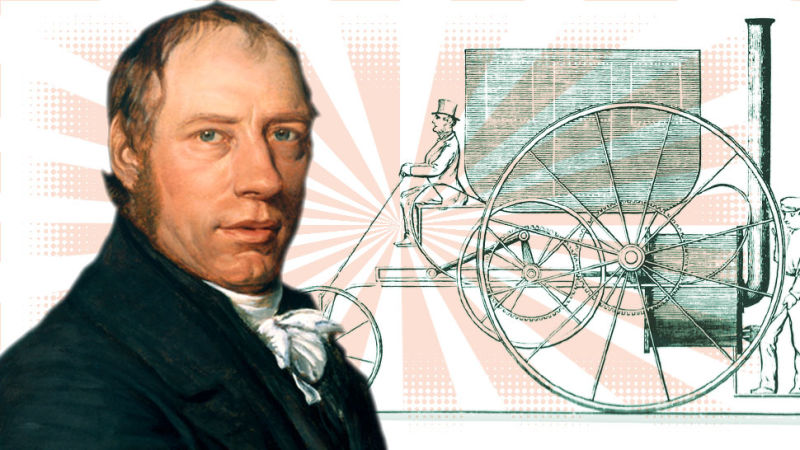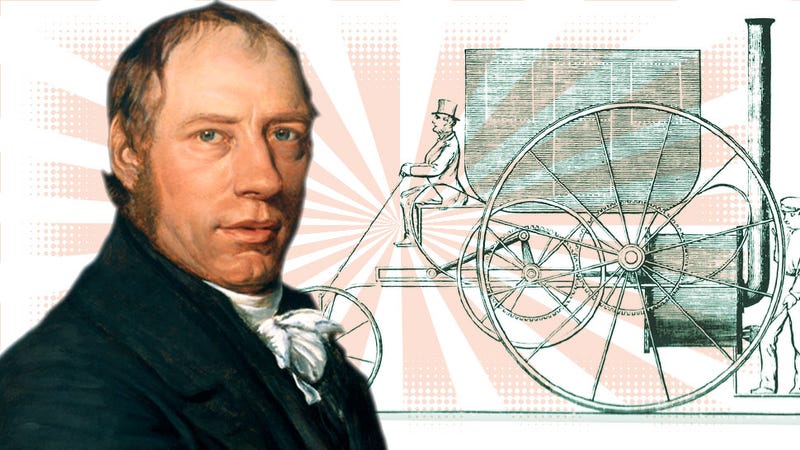
One of my personal missions as an automotive writer is to bring more attention to the very early history of cars, that very important and often overlooked century of development from the late 1700s to about 1880. I don’t want Mercedes-Benz to get away with saying they invented the automobile, because that’s bullshit. Karl Benz was great, sure, but there’s another man who deserves as much or more credit: Richard Trevithick.
It’s absolutely insane that Richard Trevithick isn’t generally placed along with Karl Benz and Henry Ford in those names that most people – even many non-gearheads – would know in reference to the development of cars. This is ridiculous because when you look at what the man achieved, it’s clear that he’s much more of an automotive pioneer than either of those other two (still wildly accomplished) men.
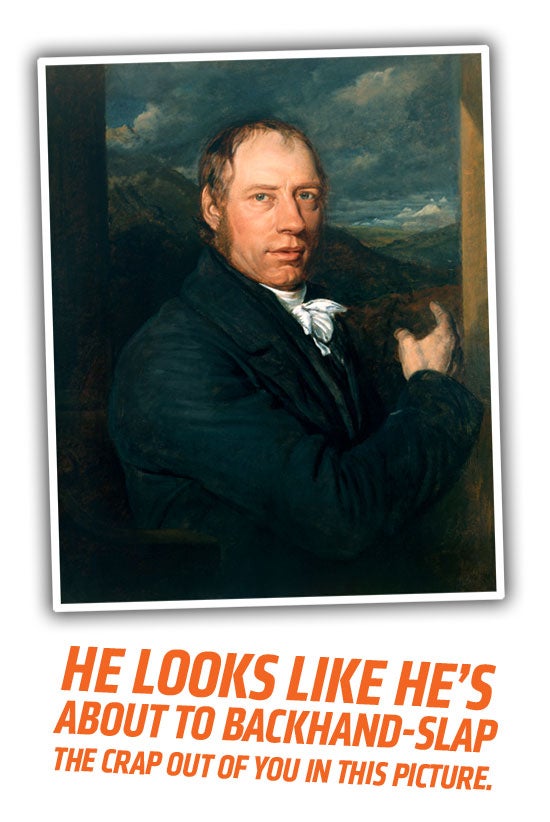
Richard Trevithick was also a big guy (sometimes called “the Cornish Giant,”) and, while gifted in math, was terrible in school and may have been illiterate all his life.
Advertisement
If you’re too lazy to read this whole article, but you’re eager to have a bit of knowledge to throw around, then I’ll encapsulate what makes Trevithick so amazing with two little facts: he was the first person to design and build a viable passenger car, and he was the person who came up with the idea that trains should run on rails.
Yep, Richie there was arguably the father of both passenger cars and railroads. It may seem odd that one person would have been the pioneer of both of those things, but in my pet theory that cars and trains are really just offshoots of the same overall machine, the automobile, it makes total sense.
Sponsored
http://jalopnik.com/this-timeline-…
In fact, Trevithick was the man responsible for the very split that gave us both cars and trains. See, at first, it was all just about self-propelled machinery, which, at that time, meant steam engines. Trevithick was developing road-going steam vehicles, and during this development had the idea that he could make things easier by reducing rolling resistance and solving steering issues by putting everything on rails, which gave birth to the railroads, the first truly successful application of the automobile (in the broad sense of the word, as a self-propelled transportation device).
But we’re a car site primarily, so I want to focus a bit on that first, and really convince all of you that every gearhead needs to know the name Trevithick. While he wasn’t the first to build a motorized vehicle capable of carrying passengers and cargo – Nicholas Joseph Cugnot gets that prize, for his ungainly 1769 steam drag, he was among the first to design something actually viable for passenger travel.

Cugnot’s steam drag was designed to be a military artillery hauler, and its design, a FWD layout with the weight so far up front it makes the average Audi look like a Tatra 77 (holy crap that’s a geeky car reference) proved pretty impractical and barely controllable.
Advertisement
Not much later, in 1784, William Murdoch made a much-improved steam car design and even built a small working model, but pioneer patent-troll James Watt made a point to keep Murdoch from ever being able to develop the idea further.
http://jalopnik.com/a-founder-of-t…
Incredibly, Richard Trevithick ended up living next door to William Murdoch in Redruth, Cornwall. As his neighbor, it’s recorded that Trevithick saw Murdoch’s model steam car working a number of times, and was familiar with the machine.
By 1801, after a number of years of designing and building stationary steam engines, Trevithick had built his own steam-powered vehicle, an experimental steam car that used a high-pressure (he had built engines up to around 145 PSI; his vehicles tended to be about 30 PSI) steam engine to get an engine powerful enough yet small enough to be practical for a vehicle.
Just as an aside, steam engine pioneer James Watt was very against high-pressure steam engines, and felt Trevithick should be hanged for introducing them.
Trevithick’s first car, called the Puffing Devil, made a run, with passengers, up Camborn Hill in Cornwall on Christmas of 1801. There’s even a song about the event:
… and here’s what a replica of the Puffing Devil looks like driving along that same road:
As you can see, the Puffing Devil was pretty crude and experimental. It’s only passenger-carrying in the sense that it’s possible for people to hang onto its framework as it runs; it wasn’t really designed as a practical passenger automobile, as such.

The Puffing Devil is also the first car to be lost out of bad drunken decision making. The Devil was partially broken while crossing a rough bit of road, so it was parked under a wooden shelter of some kind while Trevithick and his crew went to a pub for “roast goose and drinks.”
They left the fires going, and when they finally left the pub, the Puffing Devil had caught on fire. Oops.
But Richard wasn’t the kind of guy to let the destruction of pretty much the only working car in the world stop him. In 1803, he designed the London Steam Carriage, the first self-propelled vehicle designed from the outset to carry passengers.
In other words, a car.
The London Steam Carriage is, for all practical purposes, the world’s first usable passenger car. The London Steam Carriage was not some converted horse-carriage; it was developed from scratch as a motor vehicle.
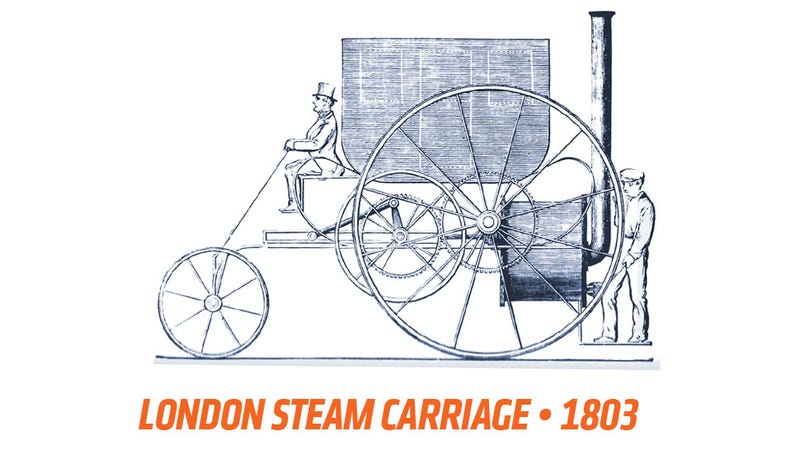
The design and engineering of the London Steam Carriage is fascinating, as it’s a product of its environment and also a first stab at an entirely new concept of transportation. Most notably, it uses colossal 8-foot high wheels, to compensate for poor road conditions and also to minimize vibrations that could put out the boiler fires.
This first car was a rear-engine, RWD machine, a three wheeler, with one tiller-steered pivot wheel up front keeping the steering system simple. The body was a carriage-like round-bottomed box, with a single door positioned at the front, like an enormous steampunk Isetta.

The engine uses a single horizontal cylinder, with a large boiler at the rear. The boiler has a pair of steam exhaust pipes exiting from it that siamese into one tall upright pipe, making the assembly look a little like headers, and with the huge rear wheels and tiny front wheel the whole thing sort of looks like a Jules Verne dragster in profile.
The patent drawings for it seem to contain some deliberate, anti-copycat errors, which would have made it, among other things, only run backwards. We’ve figured that out in modern times, and at least one fairly accurate replica exists and runs:
The London Steam Carriage made a 10 mile trip, making between 4-9 MPH, with seven or eight passengers on board, but the next night Trevithick and his partners crashed it into some house railings. You can’t really blame him, though – he didn’t really have much driving experience (just, you know, more than anyone else in the world) and I bet the London Carriages & Tea meet-up was letting out, and he probably wanted to show off a bit. Just a guess.
There is a pretty good recounting of the wreck in the book Richard Trevithick: The Engineer and the Man:
They kept going on for four or five miles, and sometimes at the rate of eight or nine miles an hour. I was steering, and Captain Trevithick and some one else were attending to the engine… She was going along five or six miles an hour, and Captain Dick called out, “Put the helm down, John!” and before I could tell what was up, Captain Dick’s foot was upon the steering-wheel handle, and we were tearing down six or seven yards of railing from a garden wall. A person put his head from to window, and called out, “What the devil are you doing there! What the devil is that thing?”
Just take a moment to think about what the guy who yelled from the window would have been thinking. It’d be like you today yelling at some loons driving an anti-gravity pod into the side of your house.
The wreck was enough to give his investors cold feet, along with comfort complaints from the passengers and the grim realization that it was still more expensive to run than a horse-drawn carriage.
Sadly, that was it for the first actual car ever made, as it was soon disassembled and its engine repurposed to drive a machine that made barrel hoops.
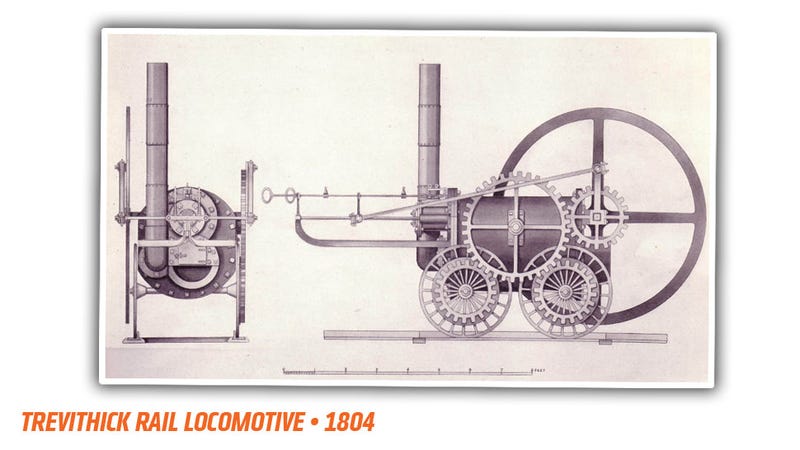
The next year, in 1804, Trevithick came up with the brilliant idea to run these steam vehicles on metal rails, which, by combining his steam automobiles with the idea of networks of metal railways, established the very concept of railroads, the transport system that was to dominate the entire upcoming century.
Despite all this, he still somehow managed to die broke, another good reminder of how useless wealth is as a way to evaluate people. Trevithick is hardly forgotten, but he also doesn’t have the same status in most gearhead’s minds that I believe he should.
The man built and drove, for all practical purposes, the very first car. This was over 40 years before Karl Benz was even born. So the next time you’re listing your motoring heroes, I’d like to plead with you to slide old Richard into your list. He’s earned it.

